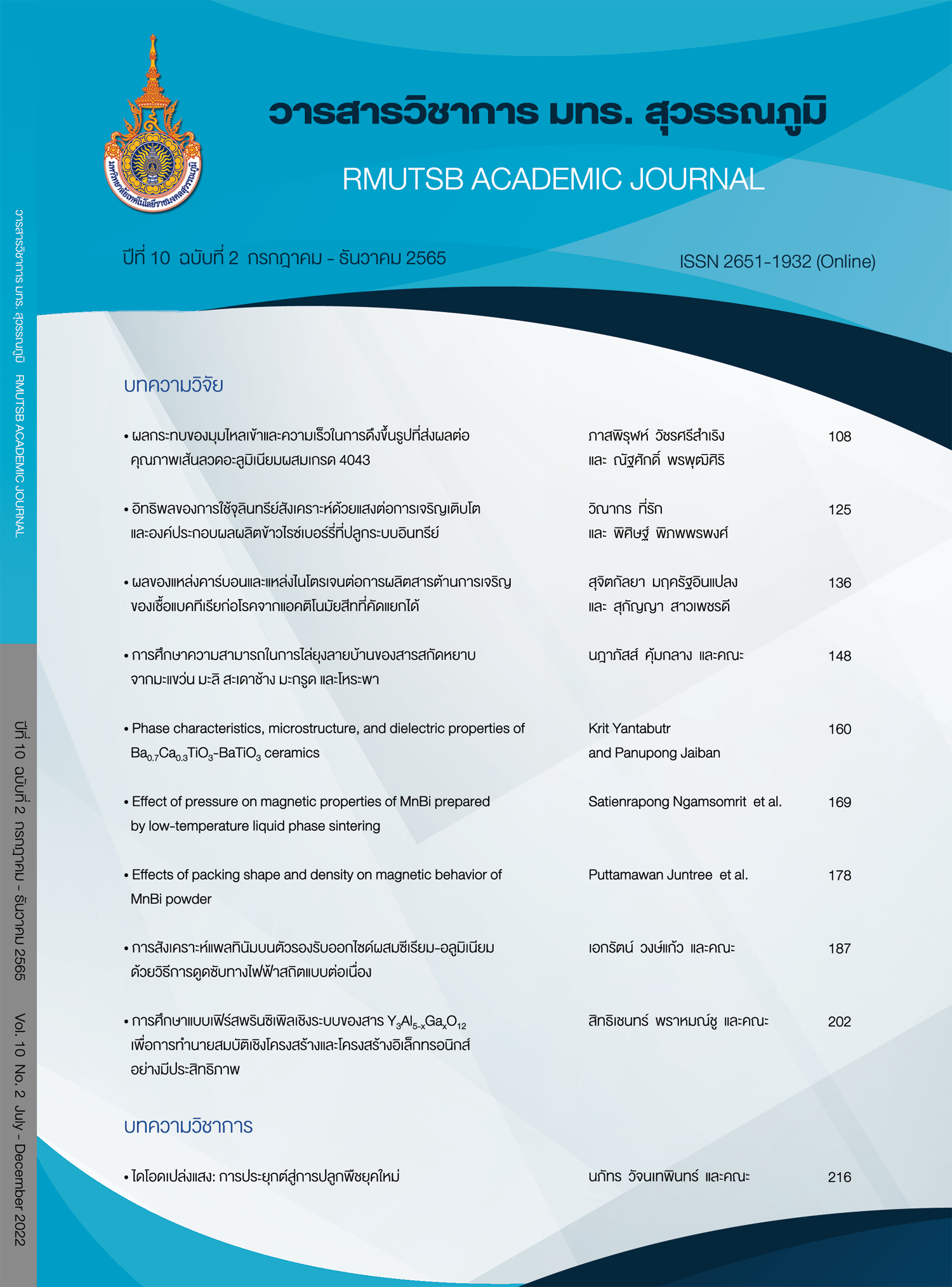Synthesis of platinum over CeO2-Al2O3 by sequential-strong electrostatic adsorption method
Main Article Content
Abstract
This research investigated the synthesis of platinum over mixed oxide of cerium-aluminum support using sequential-strong electrostatic adsorption (Seq-SEA). Platinum precursor is chloroplatinic acid (H2PtCl6). When it dissolves in water, it is in the form of PtCl62-. The maximal uptake of platinum complex was 0.42 μmol/m2 with the control of an initial pH of PtCl62- solution at 2.57 and surface loading of 1,000 m2/L. There were two experimental sets: set 1: no reduction of Pt before Seq-SEA (Seq-SEA set 1), and set 2: reduction of platinum before Seq-SEA (Seq-SEA set 2). The result showed that both sets of experiments platinum loading increased, as the number of Seq-SEA increased. Maximum Pt loadings after seq-SEA 4 times were 7.1% wt for Seq-SEA set 1, and 9.3% wt for Seq-SEA set 2. The prepared catalysts were identified the crystalline phases present in a material, revealed chemical composition information and determined an average crystalline size by X-ray Diffraction technique. The results indicated that Pt in the samples prepared by Seq-SEA set 1 with 1-3 Seq-SEA and Seq-SEA set 2 with 1-2 Seq-SEA was well dispersed. In the samples with 7.1%Pt loading prepared by Seq-SEA set 1, Seq-SEA set 2 and dry impregnation, average Pt crystalline sizes of each sample were 4.8, 4.7 and 5.1 nm, respectively. N2 adsorption-desorption technique was used for analyzing specific surface areas of all prepared samples. As Pt loadings increased, the specific surface areas decreased. Moreover, the results indicated that specific surface areas of the sample prepared by Seq-SEA set 1, Seq-SEA set 2 and dry impregnation with 7.1%Pt loading were different. There were 221.0, 227.0 and 207.7 m2/g, respectively, which were inversely correspond to an average Pt crystalline size.
Article Details

This work is licensed under a Creative Commons Attribution-NonCommercial-NoDerivatives 4.0 International License.
Published manuscript are the rights of their original owners and RMUTSB Academic Journal. The manuscript content belongs to the authors' idea, it is not the opinion of the journal's committee and not the responsibility of Rajamangala University of Technology Suvarnabhumi
References
Cho, H. R., & Regalbuto, J. R. (2015). The rational synthesis of Pt-Pd bimetallic catalysts by electrostatic adsorption. Catalysis Today, 246, 143-153.
Donohue, M. D., & Arnovich, G. L. (1998). Adsorption hysteresis in porous solids. Journal of Colloid and Interface Science, 205(1), 121-130.
Faria, L. A., & Trassatti, S. (1994). The point of zero charge of CeO2. Journal of Colloid and Interface Science, 167(2), 352-357.
Hargreaves, J. S. J. (2016). Some considerations related to the use of the Scherrer equation in powder X-ray diffraction as applied to heterogeneous catalysts. Catalysis, Structure & Reactivity, 2, 33-37.
Khdary, N. H., & Ghanem, M. A. (2014). Highly dispersed platinum nanoparticles supported on silica as catalyst for hydrogen production. RSC Advances, 4, 50114-50122.
Lambert, S., Job, N., Souza, L., Pereira, M. F. R., Pirard, R., Heinrichs, B., Figueiredo, J. L., Pirard, J.-P., & Regalbuto, J. R. (2009). Synthesis of very highly dispersed platinum catalysts supported on carbon xerogels by the strong electrostatic adsorption method. Journal of Catalysis, 261(1), 23-33.
Lee, Y. -L., Mnayan, A., Na, H. -S., Kim, K.-J., Shim, J. -O., Lee, K., & Roh, H. -S. (2020). Comparison of the effects of the catalyst preparation and CeO2 morphology on the catalytic activity of Pt/CeO2 catalysts for the water-gas shift reaction. Catalysis Science & Technology, 10, 6299-6308.
Mehrabadi, B. A. T., Eskandan, S., Khan, U., White, R. D., & Regulbuto, J. R. (2017). Chapter one - A review of preparation methods for supported metal catalysts. In C. Song (Ed.), Advances in Catalysis, Volume 61 (pp. 1-35). Burlington: Academic press.
Munnik, P., Jongh, P. E., & Jong, K. P. (2015). Recent developments in the synthesis of supported catalysts. Chemical Reviews, 115(14), 6687-6718.
Neves, T. M., Frantz, T. S., Schenque, E. C. C., Geleske, M. A., & Mortola, V. B. (2017). An investigation into an alternative photocatalyst based on CeO2/Al2O3 in dye degradation. Environmental Technology & Innovation, 8, 349-359.
Regalbuto, J. R. (2006). Catalyst preparation: Science and Engineering. Boca Raton: CRC press.
Schwarz, J. A., Contescu, C., & Contescu, A. (1995). Methods for preparation of catalytic materials. Chemical Reviews, 95(3), 477-510.
Shapovalov, S. S., Mayorova, N. A., Modestov, A. D., Shiryaev, A. A., Egorov, A. V., & Grinberg, V. A. (2022). Pt-Mo/C, Pt-Fe/C and Pt-Mo-Sn/C nanocatalysts derived from cluster compounds for proton exchange membrane fuel cells. Catalysts, 12(255), 1-14.
Thommes, M. (2010). Physical adsorption characterization of nanoporous materials. Chemie Ingenieur Technik, 82(7), 1059-1071.
Walton, K. S., & Snurr, R. Q. (2007). Applicability of the BET method for determining surface areas of microporous metal-organic frameworks. Journal of American Chemical Society, 129(27), 8552-8556.
Zhang, X., Wang, D., Chen, X., Meng, L., & Liang, C. (2022). Selective hydrogenation of anthracene
to symmetrical octahydroanthracene over Al2O3-suppored Pt and Rh catalysts prepared by strong electrostatic adsorption. Energy Fuels, 36(5), 2775-2786.


